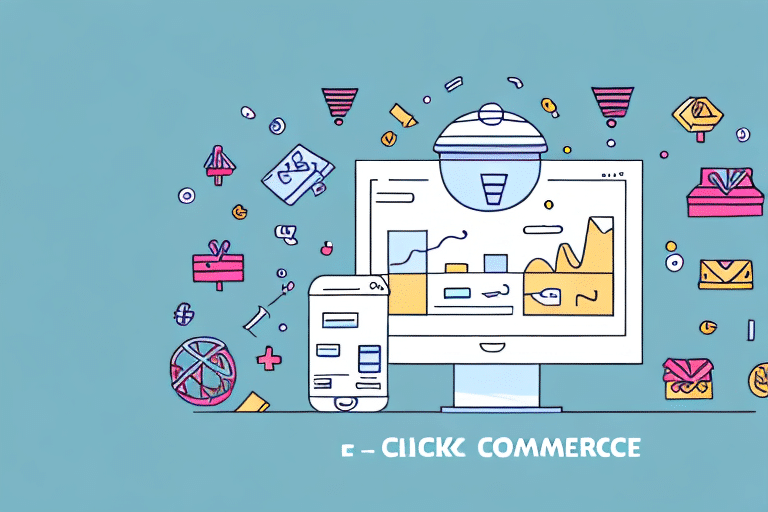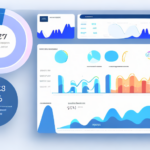Introduction to Click-Through Rate (CTR) in E-Commerce
In the competitive landscape of e-commerce, understanding the effectiveness of your digital marketing efforts is crucial. One of the key metrics that can provide deep insights into your campaign's performance is the Click-Through Rate (CTR). This metric not only gauges the engagement level of your audience but also helps in refining your marketing strategies to drive better results. In this comprehensive guide, we'll explore everything you need to know about CTR, including how to measure it, its significance, and strategies to optimize it for your e-commerce operations.
What is Click-Through Rate (CTR) and Why It's Important for E-Commerce
Click-Through Rate (CTR) is a performance metric that measures the ratio of users who click on a specific link to the total number of users who view a page, email, or advertisement. It is expressed as a percentage and is a key indicator of the effectiveness of your online marketing campaigns.
For e-commerce businesses, CTR is essential because it directly reflects how well your ads or email campaigns are resonating with your target audience. A higher CTR suggests that your content is compelling and relevant, leading to increased traffic and potential sales. According to WordStream, the average CTR across industries for Google Ads is approximately 3.17% on the search network, highlighting the competitive nature of digital marketing.
Moreover, analyzing CTR helps in understanding user behavior, preferences, and the overall effectiveness of your marketing strategies. It allows businesses to make data-driven decisions to enhance engagement and optimize their campaigns for better performance.
How to Calculate Click-Through Rate: A Step-by-Step Guide
Calculating CTR is straightforward. The formula is:
CTR (%) = (Number of Clicks / Number of Impressions) × 100
For example, if your ad receives 150 clicks out of 10,000 impressions, the CTR would be:
(150 / 10,000) × 100 = 1.5%
While a higher CTR generally indicates better performance, it's important to consider it alongside other metrics such as Conversion Rate and Cost Per Click (CPC) to get a comprehensive view of your campaign's success.
The Role of CTR in Measuring the Success of Your E-Commerce Campaigns
CTR serves as a foundational metric in assessing the success of your e-commerce campaigns. It helps you determine whether your marketing messages are effectively reaching and engaging your target audience.
By monitoring CTR, you can:
- Assess Ad Relevance: High CTR indicates that your ad is relevant and appealing to users.
- Identify Effective Channels: Determine which platforms or channels yield the highest engagement.
- Optimize Content: Refine your ad copy, visuals, and call-to-actions based on CTR insights.
For instance, a study by WordStream found that the top 10% of Google Ads campaigns have a CTR of 7.11% on the search network, significantly higher than the average. This underscores the importance of continuously optimizing your campaigns to achieve superior engagement levels.
Commonly Used Metrics to Measure CTR and Their Significance in E-Commerce
While CTR is a crucial metric, it's important to analyze it in conjunction with other key performance indicators to gain a holistic understanding of your campaign's effectiveness. Here are some of the most important metrics:
Conversion Rate (CR)
The Conversion Rate measures the percentage of users who take a desired action after clicking on your ad, such as making a purchase or signing up for a newsletter. A high CTR coupled with a high conversion rate indicates that not only are your ads attracting clicks, but they are also driving valuable actions.
Cost per Click (CPC)
Cost Per Click (CPC) indicates how much you're paying for each click on your ad. Monitoring CPC helps you manage your advertising budget effectively and understand the financial efficiency of your campaigns.
Bounce Rate (BR)
The Bounce Rate signifies the percentage of visitors who navigate away from your site after viewing only one page. A high bounce rate may suggest that your landing page isn't meeting user expectations, even if your CTR is high.
Time on Site
Time on Site measures how long visitors stay on your website after clicking on an ad. Longer time on site typically indicates higher engagement levels and can correlate with higher conversion rates.
Factors Affecting Click-Through Rate: How to Optimize Your E-Commerce Strategy for Better Results
Several factors influence CTR, and understanding these can help you optimize your e-commerce strategies:
Ad Placement
The position of your ad on the platform can significantly impact its visibility and, consequently, its CTR. Ads placed at the top of search results or prominently on a web page generally receive higher CTRs.
Ad Relevance
Ensuring that your ads are relevant to your target audience is crucial. Personalized and targeted ads tend to perform better, as they align more closely with users' interests and needs.
Ad Quality
The quality of your ad, including its design, message clarity, and overall appeal, plays a vital role in attracting clicks. High-quality ads are more likely to engage users and encourage them to take action.
Ad Targeting
Effective targeting ensures that your ads reach the right audience. Utilizing demographic, geographic, and behavioral targeting can help in delivering your ads to users who are more likely to be interested in your offerings.
Compelling Headlines and CTAs
Crafting attention-grabbing headlines and clear, action-oriented call-to-actions (CTAs) can significantly boost your CTR. Your headline should succinctly convey the value proposition, while the CTA should prompt users to take the desired action.
Best Practices for Improving CTR in Your E-Commerce Campaigns
Implementing best practices can lead to substantial improvements in your CTR. Here are some strategies to consider:
- Optimize Ad Copy: Use clear, concise, and compelling language that resonates with your target audience.
- Use High-Quality Images: Visuals play a crucial role in attracting attention. Ensure that your images are relevant and of high quality.
- Implement Responsive Design: Ensure that your ads are optimized for all devices, including mobile, to reach a broader audience.
- Utilize A/B Testing: Experiment with different ad variations to identify which elements drive higher CTRs.
- Leverage Social Proof: Incorporate testimonials, reviews, or endorsements to build trust and encourage clicks.
Optimize Your Landing Pages
Your landing page should align with the ad content and provide a seamless user experience. A well-designed landing page with a clear CTA can enhance the effectiveness of your CTR by guiding users towards conversion.
Retargeting Campaigns
Implementing retargeting strategies allows you to reach users who have previously interacted with your brand but did not convert. Personalized retargeting ads can re-engage these users and improve your overall CTR and conversion rates.
How to Analyze CTR Data and Use It to Optimize Your E-Commerce Operations
Analyzing CTR data is essential for refining your marketing strategies and enhancing campaign performance. Here's how to effectively analyze and leverage CTR data:
- Regular Monitoring: Regularly track your CTR to identify trends and assess the performance of different campaigns.
- Segment Your Data: Break down your CTR data by demographics, location, device type, and other relevant segments to uncover specific insights.
- Identify Successful Elements: Determine which ad elements (such as headlines, images, or CTAs) are driving higher CTRs and replicate their success.
- Spotting Weaknesses: Identify underperforming ads and analyze the reasons behind their low CTRs to make necessary adjustments.
- Data-Driven Decisions: Use the insights gained from CTR analysis to inform your marketing strategies and optimize your campaigns for better results.
Utilizing Analytics Tools
Employing analytics tools like Google Analytics can provide in-depth insights into your CTR data. These tools allow you to track user behavior, measure campaign performance, and identify areas for improvement.
Benchmarking Against Industry Standards
Comparing your CTR with industry benchmarks can help you gauge your performance. Understanding where you stand relative to competitors enables you to set realistic goals and strive for continuous improvement.
Understanding the Relationship between CTR and Conversions for Improved ROI in E-Commerce
While CTR is a vital metric, it's important to understand its relationship with conversion rates to truly measure your campaign's effectiveness and ROI.
A high CTR indicates strong engagement, but without corresponding conversions, the effectiveness of your campaign is limited. To optimize ROI, focus on not just attracting clicks but also ensuring that these clicks lead to desired actions.
Here are some strategies to align CTR with conversions:
- Targeted Messaging: Ensure that your ad content is aligned with the landing page content to provide a consistent user experience.
- Streamlined Conversion Path: Simplify the steps required to convert, reducing friction and enhancing the likelihood of action.
- Quality Over Quantity: Focus on attracting high-quality traffic that is more likely to convert, rather than just aiming for a high CTR.
- Optimize for Mobile: With the increasing use of mobile devices, ensuring that your site is mobile-friendly can significantly impact conversions.
Tracking both CTR and conversion rates provides a more comprehensive understanding of your campaign's performance and allows for more informed optimizations to improve ROI.
The Future of Click-Through Rate (CTR) and Its Implications for E-Commerce Businesses
The landscape of digital marketing is continuously evolving, and the future of CTR will be shaped by several emerging trends:
Artificial Intelligence and Machine Learning
AI and ML are revolutionizing how ads are targeted and personalized. By leveraging these technologies, businesses can create more relevant and engaging ads, thereby improving CTR and conversion rates.
Voice Search Optimization
With the rise of voice-activated devices, optimizing for voice search is becoming increasingly important. This shift will influence how ads are crafted and targeted, potentially affecting CTR dynamics.
Interactive and Rich Media Ads
Interactive and rich media ads, such as video ads and interactive banners, are gaining popularity. These formats can enhance user engagement and lead to higher CTRs by providing a more immersive experience.
Privacy and Data Regulations
As data privacy concerns grow, businesses need to adapt their strategies to comply with regulations like GDPR and CCPA. This may impact how data is used for ad targeting, influencing CTR and overall campaign strategies.
Mobile-First Advertising
The continued shift towards mobile-first advertising means that optimizing ads for mobile devices is essential. Ensuring that ads are mobile-friendly can significantly enhance CTR and user engagement.
Conclusion
Click-Through Rate (CTR) is a fundamental metric that plays a critical role in assessing and optimizing the effectiveness of your e-commerce marketing campaigns. By understanding and leveraging CTR, businesses can enhance user engagement, refine their marketing strategies, and ultimately drive better conversions and ROI.
However, it's important to view CTR in the broader context of other performance metrics to gain a comprehensive understanding of your campaign's success. Regular analysis and optimization based on CTR and related metrics can help e-commerce businesses stay competitive in the dynamic digital marketing landscape.




















